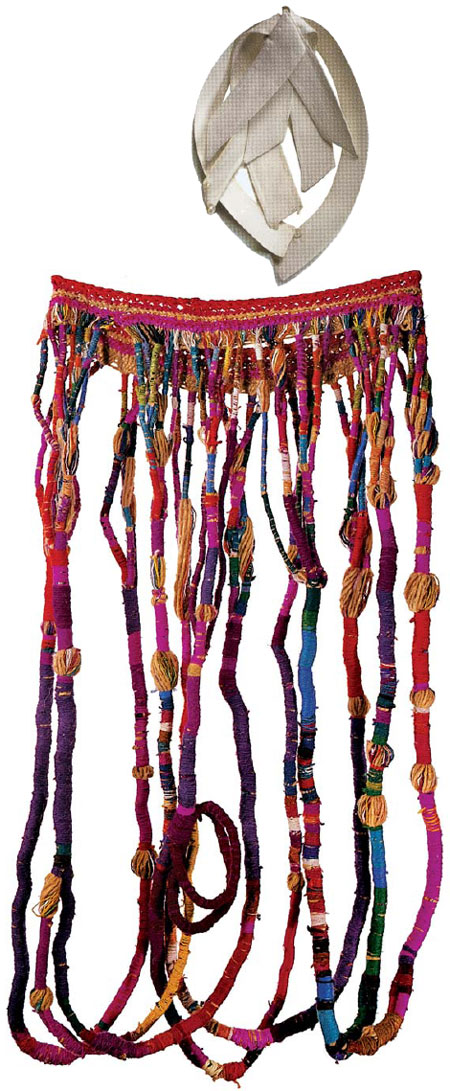A fabric artist's global 'graffiti'
By Leslie Camhi (China Daily/Agencies)
2011-04-11 15:26
 |
Large Medium Small |
 |
|
Sheila Hicks's fiber works ''Cols,'' right, made of linen and buttons, and 'Falda,'' made of wool, below. Photographs by Bastiaan Van Den Berg / Addison Gallery of American Art |

PARIS - For nearly half a century, Sheila Hicks has been working at the intersection of art, design, crafts and architecture. Her resistance to being slotted into any one of these categories may go some way toward explaining how her work, which ranges in scale from near-miniature to monumental, has long eluded the art world's attention.
Now that is changing. "Sheila Hicks: 50 Years," at the Institute of Contemporary Art in Philadelphia, highlights the work of this classically trained modernist - a global artist before the term was fashionable - who adopted textiles as her primary medium and expanded it exponentially.
"I have no interest in classifying Sheila as a contemporary artist whom we just 'missed,'�? said Jenelle Porter, who organized the Philadelphia show. Ms. Hicks, she explained, has worked with artisans and craftspeople all over the world, and she's invented new techniques and materials.
"She goes so much farther than anyone in the design world or the craft world or the art world," Ms. Porter said. "She crisscrosses back and forth with so much ease."
Ms. Hicks, 76, who lives in Paris and New York, was born in Hastings, Nebraska, in 1934. Her great-aunts instructed her in spinning, sewing and weaving.
At the Yale School of Art, she studied with Josef Albers, the German-born head of the art department, who had brought Bauhaus ideals to New Haven, Connecticut, and with George Kubler, the influential historian of Latin American art. A picture of Peruvian mummy bundles, shown in Dr. Kubler's class, sparked Ms. Hicks's interest in textiles.
Ms. Hicks went to Chile on a Fulbright grant and traveled around Latin America, absorbing the influence of weavers in Ecuador, Bolivia and Peru. She received a master of fine arts degree from Yale University, then returned to Mexico, where she exhibited her minimes, a series of framed weavings, most no bigger than a hand. Some of her weavings entered the collection of the Museum of Modern Art. She married a Mexican-German beekeeper, and had a daughter.
Having lived briefly in Paris in 1959, she returned here in 1964. Her second husband, a Chilean artist (with whom she had a son, the filmmaker Cristobal Zanartu), introduced her to surrealist and Latin American circles in Paris.
Her first big public commission was for a wall hanging at the restaurant of Eero Saarinen's new CBS building in New York.
A defining moment in Ms. Hicks's career came with her invitation to exhibit at the Biennial of Tapestry in Lausanne in 1967.
"I showed something I had just made in Chile, out of linen, with clusters of long, free-hanging cords suspended from the ceiling," Ms. Hicks recalled. A patron of tapestry said to her, "'Mademoiselle, I hear you are exhibiting a tapestry.' I replied, 'Yes, Madame, here it is.' And she said, 'I do not see a tapestry.'"
"It became a running joke," Ms. Hicks said. "What is tapestry and what is not? And what should we squelch before it goes too far? I was moving around between different techniques - of stitching, wrapping, braiding, weaving, twining." She added, "My work was equated with a kind of graffiti."
But she began to be noticed: from her bas-relief medallion tapestries for the Ford Foundation headquarters in Manhattan (1966-67); to her wall hangings for a fleet of Air France 747s, stitched by hand in white silk (1969-77); to commissions for King Saud University in Riyadh, Saudi Arabia (1982-85); and a cultural center in Fuji City, Japan (1992-93).
At the same time her temporary, poetic installations of found fabrics - a cascading mountain of some five tons of clean Swiss hospital laundry, for example, or the floating curtains of baby bands (used to bind a newborn's umbilical wound), which she showed in a gallery in Kyoto in 1978 - explore the pervasive presence of cloth in every facet of human existence, from birth until death.
And if living in Paris has helped keep Ms. Hicks from the American art mainstream, it's also had its advantages. "There's an immense amount of freedom in being an outsider," Ms. Hicks said. "You're a heretic. So it becomes a way of life."
| 分享按钮 |